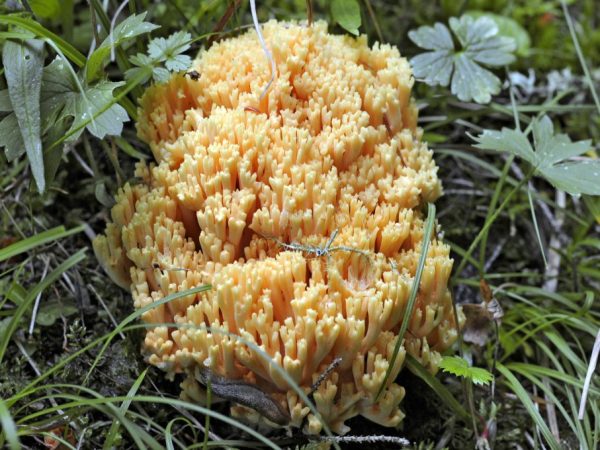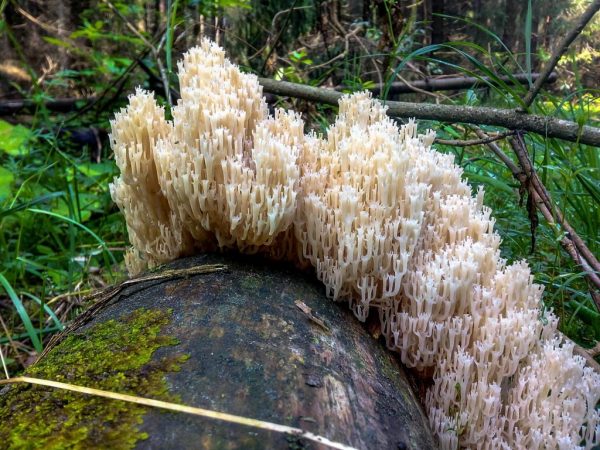Features of the coral mushroom
Coral mushroom belongs to the exotic representatives of the forest kingdom. It is listed in the Red Book of Russia. The organism grows in deciduous and mixed forests, creating mycorrhiza with beech, birch or pine, less commonly found on alder and linden. It is sometimes found on sick and weak plants.

Features of the coral mushroom
Description
A beautiful coral mushroom of an unusual shape, indeed at first glance indistinguishable from a marine colonial organism, is the official representative of the Hericium genus. The Latin name is Hericium coralloides. People call mushrooms "coral hedgehogs", in scientific circles - xylotrophs, branched and trellised gericia.
This real natural decoration of the forest rarely catches the eye of lovers of "quiet hunting". The description contains the following characteristics of this species:
- fruit body in the form of a bush;
- thorns: different shapes, fragile structure, small size (up to 1 cm);
- hollow branches;
- scaly base;
- branch length up to 30-40 cm;
- color white or beige (depending on the type).
The annual mushroom bears great similarity to its underwater cousin. With age, its color changes and becomes darker, brownish or yellow. The underground part - the mycelium of the barnacle fungus continues to live and produce a new crop regularly, from year to year.
The flesh of these organisms is white or pale pink. In young organisms, it is tender, soft and elastic, and in old organisms it becomes tough and hard. If you press on it, it turns red. Coral mushroom has a rich aroma.
Mushrooms in the form of branching corals have lateral shoots that are used dried. After drying, they turn orange.
The coral mushroom is characterized by its outwardly scary thorns, which are in fact so fragile that they disintegrate upon light touch.
The spores of this coral fungus are in the form of a white ball, sometimes the ball stretches out and takes the form of an ellipse. However, it is possible to consider this only with a microscope.
It grows in the northern regions of the country: in the Far East, the Urals, Siberia, as well as in the Caucasus and Krasnodar Territory. Harvesting times are July, August and September, in rare cases the season lasts until mid-October.
Views
Coral mushrooms come in several varieties, which differ in appearance and taste. In our region, the Alpine hedgehog is widespread, which grows in coniferous forests on damaged spruce stumps, cedars, fir or pines.
This organism is considered edible and has the following varieties:
- golden;
- amethyst;
- aciniform;
- yellow;
- truncated;
- reed.
Description of species

Coral mushrooms cannot be poisoned
All edible coral mushrooms have a pleasant aroma, are easy to prepare, and yield a large harvest. Inedible varieties will not harm the body, they cannot be poisoned. Culinary specialists skillfully know how to cook and serve them in different forms.
Bear paw
Ramaria coral, or bear's paw, or mushroom noodles grows in spruce and pine forests. Its stem has dichotomous branching, with a white color inside.
Irina Selyutina (Biologist):
Dichotomous branching is called such (usually in the shoot of higher plants, but the concept is also used for other groups, if there is an external similarity), when at the top of the shoot the main axis (stem) is divided into two equally developed axes, and then it stops growing. Therefore, we can say that as a result of such branching, a U- or V-shaped fork is formed.
In young organisms, the surface is covered with yellow spores. With age, it becomes pale orange or reddish in color. Chanterelle and coral horned fungi are believed to share common ancestral forms.
In height, adult organisms reach up to 20 cm, 2 cylindrical processes appear from the central trunk, which then form the main branches of the fruiting body.
The pulp is similar in color to marble, has a pleasant herbal aroma.
Harvesting should be from late August to early October, they grow in coniferous forests.
Reed horn
The pale yellow sprout that has emerged from under the ground and has an external resemblance to the human tongue is called the reed horn (Clavariadelphus ligula). Organisms of this species grow in conifers, forming mycorrhiza with spruce and fir.
Irina Selyutina (Biologist):
The fruiting body of the reed stalk does not branch, it is unrealistic to distinguish the cap and leg in it. Due to its appearance, it is customary to call it clavate.
The species belongs to saprophytes of the 4th edible category. It reaches a height of 10 cm. It has a pale beige color.
Clavulina wrinkled
This mushroom has a weak bushiness, unlike the rest of its brothers. Its branches resemble smooth or wrinkled animal horns. They reach a diameter of 0.4 cm and are characterized by sharp ends that become blunt with age. In total, the body reaches a height of 15-17 cm.
The surface color is usually white or pale cream. The white, fragile pulp does not have any aroma.
Coral mushrooms grow in conifers, on mosses, usually in small families from August to October. This organism belongs to the 4th category of edibility, it is not in great demand among culinary experts due to its poor quality. The white coral mushroom has no similar species.
Beneficial features

Mushrooms contain useful substances
Due to their composition, these mushrooms have useful properties:
- lower blood cholesterol levels;
- have a positive effect on liver function;
- remove toxins;
- improve the functioning of the heart and nervous system;
- restore immunity;
- stabilize blood pressure.
Coral mushroom is rich in vitamins, calcium, iron, phosphorus, fiber, polysaccharides and amino acids.
Application
These amazing mushrooms have found their application in folk and traditional medicine, in cooking and cosmetology.
Application in medicine
In medicine, they are used as natural antidepressants and antibiotics. They are used to prepare medicines that help develop antibodies that destroy viruses and bacteria.
Coral acts as a strong stimulant, erinocin E in its composition helps in the treatment of Alzheimer's disease.
In China, it is used as an antineoplastic agent, as well as to restore and strengthen the body after a course of chemotherapy.
The species allows you to treat severe worm lesions (including tapeworms).
Glycogen in the composition of coral mushrooms helps to heal nervous disorders and immunodeficiency, has the unique property of promoting the function of hematopoiesis. It removes free radicals and protects the body from radiation.
Application in cosmetology
Cosmetologists use tinctures and decoctions of white coral mushroom to tone the skin, make it elastic, smooth out expression lines and restore its moisture balance.
Cooking applications
The forest coral mushroom has no special taste. It has a low calorie content, so it is perfect for diet food.
It is added to soups and snacks, salads and even sweet dishes are prepared.
The recipe for an exotic dessert: dry fruit bodies are poured with warm water and left in this state for 1-2 hours, after which the liquid is drained and soaked in peach or other syrup. Garnish with fresh mint or strawberries before serving.
Dishes are prepared only from young organisms, since the old ones are hard and dry.
After purchasing or harvesting in the forest, it is important to properly prepare and store this mushroom. Best stored in a refrigerator or basement.
Conclusion
Coral mushrooms are a rare and unusual species, most often edible. They have useful qualities, which allows them to be used in various fields: in the treatment of diseases and in the recovery period, in cosmetology and cooking.



